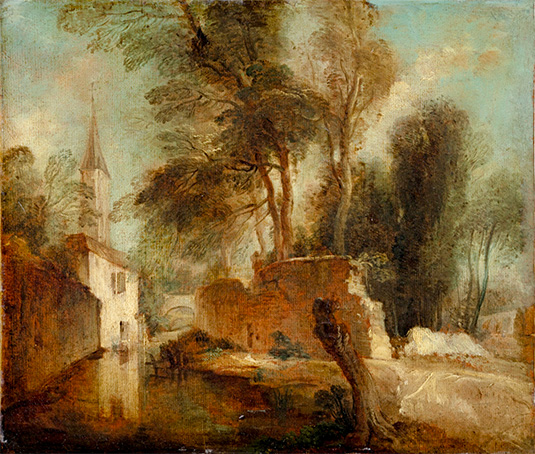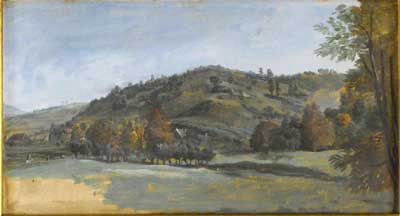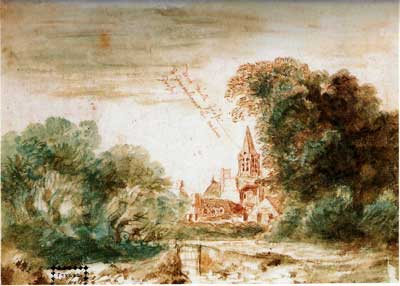
- Home Page
- Accepted
Paintings & Copies - Doubtful
Attributions - Doubtful Textual References
- Alternative
Titles - Collectors &
Museums - Bibliography
- Search Abecedario
- Watteau &
His Circle
La Bièvre à Gentilly
Entered July 2016; revised June 2025

Whereabouts unknown
Oil on paper, mounted on canvas
29 x 34 cm
ALTERNATIVE TITLES
Paysage de Nogent
Paysage des environs de Paris
PROVENANCE
Paris, collection of Raoul Dastrac (1891-1969; painter).
EXHIBITIONS
London, Royal Academy, Landscape in French Art (1949), cat. 97 (as by Watteau, The Bièvre at Gentilly, lent by a private collector, Paris).
Zurich, Kunsthaus, Schönheit des 18. Jahrhunderts (1955), cat. 348 (as by Watteau, Das Bièvre in Gentilly, lent by a private collector, Paris).
Paris, Cailleux, Watteau et sa géneration (1968), cat. 43 (as by Watteau, La Bièvre à Gentilly, lent by a private collection, Paris).
SELECT BIBLIOGRAPHY
Mathey, “A Landscape by Watteau” (1947), 273-74.
Adhémar, Watteau (1950), cat. 109.
Mathey, Watteau, peintures réapparues (1959), 60-61, 68, cat. 64.
Macchia and Montagni, L’opera completa di Watteau (1968), cat. 139.
Posner, Watteau (1984), 109-10.
Roland Michel, Watteau (1984), pl. III.
New York, Colnaghi, Claude to Corot (1990), 85-86.
Temperini, Watteau (2002), cat. 60.
REMARKS
Although the attribution of this painting to Watteau has been accepted by many modern scholars, it has not been seen since it was exhibited a half century ago in Paris. Its whereabouts since Dastrac’s death in 1969, the year after it was last exhibited, are unknown. As best as can be judged from the published photographs of the work, it seems likely that the picture is indeed by the artist. The brushwork and the rhythmic structure of the branches and foliage argue in favor of that attribution.

La Bièvre à Gentilly is singularly exceptional within the artist’s oeuvre. First, it is a landscape without figural staffage, and thus is unlike Watteau’s other landscapes, such as Le Marais, Veüe de Vincennes, and La Chute d’eau. Second, it is executed in oil on paper, a medium without parallel in his oeuvre. It is not merely a sketch, as Marianne Roland Michel noted, but more importantly, an oil sketch done from nature. It is, of course, related to the celebrated oil sketches on paper executed en plein air by Alexandre François Desportes (1661-1743) in the decades before and after 1700. Although Desportes produced a bountiful number of these oil sketches, it seems likely that other French artists of the time also turned to the medium. We do not have extant examples of such work, yet the practice was sufficiently well known that it was singled out in 1708 by Roger de Piles in his Cours de peinture par principes (pages 247-48). He suggested that artists should not only draw from nature and annotate their drawings with observations about the subtle color variations found there, but they should also make oil sketches outdoors. De Piles implied he himself had experimented with this medium and in his text he actually instructs artists on how they should choose thick paper, pack their colors, brushes, oil, and palette in a flat box, and go into the countryside to paint directly from nature. This, he assured the reader, is the best way to record the true colors in a more detailed and exact way. After the sketch was dry and varnished, one could go back to the site to retouch the principal features and finish the sketch from nature. De Piles was patronized by Pierre Crozat, and thus Watteau would undoubtedly have known his theories. Disappointingly, though, the colors in Watteau’s oil sketch are limited and not as fresh as those in Desportes’ studies.
As an interesting sidelight, Watteau’s pupil Pater also made such oil sketches on paper. One in the collection of the marquis de Branbres was sold in Paris, Hôtel Drouot, June 14, 1900, lot 34. It showed a structure built on posts over water and relates to a subject in several of Pater’s landscapes. The curious thing is that the Pater oil study measured 29 x 34 cm, the very size of Watteau’s.

Watteau, Landscape with a View of a Distant Town, red chalk and watercolor, 16.2 x 22 cm. Haarlem, Teylers Museum.
In Watteau’s oeuvre, the closest analogies to this landscape study are his landscape drawings where he added watercolor (as well as color notations), thus producing a comparable sense of spontaneity in recording a site. One of the most striking examples is a drawing in the Teylers Museum (Rosenberg and Prat 135) that, coincidentally, also depicts trees along a waterway and a village dominated by a church steeple.
When Jacques Mathey first published Watteau's oil sketch, he identified the site as the Bièvre River at Gentilly, and claimed that several of Watteau’s drawings of landscapes with rivers also represented the Bièvre. Although certain of the drawings, especially the one showing the buildings in the Gobelins area (Figures de différents caractères, plate 23), may be studies along the Bièvre, it would be foolhardy to claim this for all the drawings. Likewise, there is no proof to Mathey’s assertion that the painting represents that river; no recorded views of that site support his thesis. Nonetheless, his title has remained in place with few exceptions. Adhémar was cautious in labeling the site just a landscape in the surroundings of Paris. All other authors, including Macchia and Montagni, Ferré, Posner, Roland Michel, Conisbee, and Temperini, retained Mathey’s title. We use it here only for convenience.
Mathey first dated the painting between 1709 and 1712, but a few years later he placed it c. 1713. Adhémar preferred a later date of 1715, while Conisbee chose 1714. Temperini considered it still later, c. 1716-17. Since the picture cannot be viewed firsthand and we have little in Watteau’s oeuvre to compare it with, any conclusion may be unwise.
Despite our emphasis on the uniqueness of this work, Watteau may well have executed other such landscapes. One of the most intriguing, especially in the present context, is a painting attributed to Watteau that was sold in London on March 17-18, 1758, by Dr. Robert Bragge, a dealer with access to authetic paintings in Paris. Described simply as “A View of a Church,” it was of comparable dimensions, measuring 38.1 x 28 cm, but it may have been a vertical composition. Probably Watteau executed other oil studies on paper, just as he executed gouache studies on vellum. Scattered references to such oddities in old auction catalogues suggest that we still have much to learn about Watteau and his oeuvre.